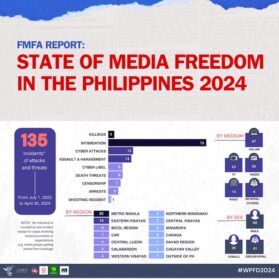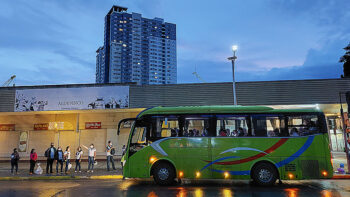
CEBU CITY (MindaNews / 11 June) — “Only he is truly a patriot who, whatever his post, high or low, tries to do the greatest possible good to his countrymen.” These were words uttered by Apolinario Mabini, the Brains of the Philippine Revolution, an educator, lawyer and statesman who served first as a legal and constitutional adviser to the Revolutionary Government, and then as the first Prime Minister of the Philippines upon the establishment of the First Philippine Republic.
As we celebrate the 125th anniversary of our country’s Independence – declared on June 12, 1898 after our revolutionary ancestors vanquished the Spanish Empire – it might be very important for us Filipinos to ask: how can we be patriots today? How can we truly manifest the sense of being makabayan or our love for or devotion to our country today considering the gargantuan problems we face: from the very wide gap between a very few rich and a great majority who are poor, the control of our economy by TNCs and the oligarchy, corruption in government, the reality of impunity in matters related to basic human rights, high unemployment rates, galloping inflation, massive impact of calamities owing to climate change, continuing landlessness of the peasants and the dislocation of our indigenous peoples from their ancestral domain and so many others.
Generations of Filipinos going back to the Spanish colonial period until the contemporary history of our country have fought revolts against their oppressors that culminated in revolutionary movements in the hope that the country can truly be free, just, democratic and sovereign. Throughout the Spanish era, more than 200 revolts across the archipelago were staged by our brave ancestors including those led by women babaylans and those led by Dagohoy, the Silangs, Bankaw, Sumoroy up to the Confradias in Central Luzon.
Then came the likes of the more known Filipino heroes: Rizal, Bonifacio, Mabini, the del Pilars, the Lunas, Tandang Sora and so many others. One notable fact is that many of them were young men and women like Hermano Pule and Gregorio del Pilar. Fast forward and the youth’s participation in radical politics advancing a revolutionary agenda became even more prominent.
This was especially true for the youth awakened by the political upheavals in the 1960s which was sweeping across the world. In the Philippines this was the youth who took centerstage in the country’s politics with the now historic First Quarter Storm. It would be a youth movement that would bring tens of thousands of young people out in the streets, facing the dictator’s absolute power with its military’s might and which led to a number eventually going up the hills to take up arms.
The generation who dared challenge the dictator’s brutal response to their cry for freedom expanded to the generation of “martial law babies.” As the fight against imperialism, feudalism and bureaucrat capitalism expanded from the alliance of youth, peasants, workers, urban poor and indigenous people to the middle forces – especially heightened by the assassination of ex-Senator Ninoy Aquino – the days of Marcos authoritarian regime were numbered and when EDSA took place in 1986, he and his political dynasty was toppled. (Only to be resurrected in 2022, unfortunately).
The world and the country have radically changed since the years of the Philippine Revolution (1890s) to the contemporary era of the 1960s-1980s. Today the term VUCA – coined in 1987 by theorists Burt Nanus and Warren Benis – has become a way to describe the global reality, one that is characterized by volatility, uncertainty, complexity, and ambiguity.
This is the world that the Filipino youth is faced with. And their country is certainly no exception. There is still a wide disparity between the rich and poor, their government – from national to the local government units – remains incapable of providing them a secure and safe future. Educational and employment opportunities are still only available to a few. No one can predict when the next disastrous calamity will strike; despite this reality, they know that little is done to mitigate the impact of climate change. Households find it more difficult now to hold on to strong family ties creating all kinds of mental disturbances for the youth. And drugs are flooding the neighborhoods and even if they are not users, they, too, could be victims of extra-judicial killings perpetuated by those in power.
So how are the Filipino youth today able to maneuver through this volatile, uncertain, complex and ambiguous society? Faced with this rather bleak reality, how can the Filipino youth of today (those of the Millennial and Gen-X generations) be expected to even consider the question: how can we be patriots? Are they worried about the state of this country’s political reality? Do they even care what has happened to the Independence dream of their ancestors? Like the previous youth generations, are they willing to struggle for their country’s liberation? Of course, they are the ones who can answer these questions.
Among the older generation today – from parents to teachers and others in authority – there is a continuing lamentation regarding the values, behavior and attitude of the youth. You hear these kind of comments: they feel so entitled that they would pursue what they please despite the objections of elders, they are continuously hooked on to their gadgets and are lost in their own worlds, they hardly have any social involvements, whatever is earned is immediately splurged in having a good time and they would rather live in the moment and not worry about the long-term or securing their future.
Clearly, the generation gap remains in place. And the lesson remains the same: it is the right of the youth to decide for themselves what they want to do especially if this does not harm any person or the planet. The elders must give them space and not dictate their expectations on them which are based on their own context. People of the baby boomers and even Gen X generations: wake up, your children are living in a very different context as yours! It may be difficult to maneuver through this contentious landscape but if we allow the youth to chart their own destiny, we might just be surprised with the outcome!
Still we hope the youth will live up to the challenge of patriotism. In the last elections we saw the possibility of a youth awakening although it seems to have become dormant. But who knows, in the near or even far future, something might provoke this youth power to be unleashed! If it comes to pass, it will certainly be in a very different form of struggle of those against the Spanish and American colonial regimes and recently with the Marcos dictatorship. After all the youth of today have the “weaponry” not available to their elders who struggled, namely the availability of computers, mobile phones and so many other gadgets! And the whole internet is at their command, no matter the unstable internet connections still bedeviling this country!
How the youth of today will use these “weapons” to advance a revolutionary agenda fit for the times is what we elders can challenge them to pursue! Is there at all a possibility that this could take off? I know of one person – who situates himself between Gen X and the millennial generation – who has come up with a concrete plan of action, which he refers to as a TAYO movement. And it is very interesting where he draws his inspiration in tapping into the computer technology to propose a way for the youth to be engaged in a radical form of social-ecological advocacy. And it is unleashed mainly online!
This person evolved this concept which has been transformed into an APP already existing in the internet from an unexpected source. The philosophical theory that undergirds the TAYO is derived from the late Camilo Osias who in 1940 wrote a book that should be required reading for Filipino students today – The Filipino Way Of Life; The Pluralized Philosophy.
Today the distinguished Camilo Osias – first Filipino Superintendent of Schools (1915 to 1916), Assistant Director of Education (1917 to 1921), later Secretary of Education (1940s), a lecturer at the University of the Philippines (1919 to 1921), 1934 member of Constitutional Convention in 1934, National Assembly member in 1935, Senate President (1952-3) – is hardly known. However, his thoughts that go back almost eighty years ago can now be retrieved in a manner that we can all gain insights into how we can be patriots of today, especially for the youth! In a column that will follow this one which I hope to publish in a day or two, I will present what this TAYO philosophy is all about and how it can be mobilized for advancing the struggle via online activism, which is very appropriate for the youth of today!
To celebrate our Independence Day, here is one challenge Mr. Osias raised in 1940 which remains very relevant for all of us Filipinos: “Under the… Tayo, or pluralized concept, there is no room for the practice of ‘Let (Juan) do it.’ Everybody must do his duty and bear his share of the burden and responsibility. Participating, thinking, and doing are prominent features of the pluralized philosophy. The people must be… be schooled in the lessons of justice, liberty, and democracy.”
(MindaViews is the opinion section of MindaNews. Redemptorist Brother Karl Gaspar is Mindanao’s most prolific book author. Gaspar is also a Datu Bago 2018 awardee, the highest honor the Davao City government bestows on its constituents. He is presently based in Cebu City).






